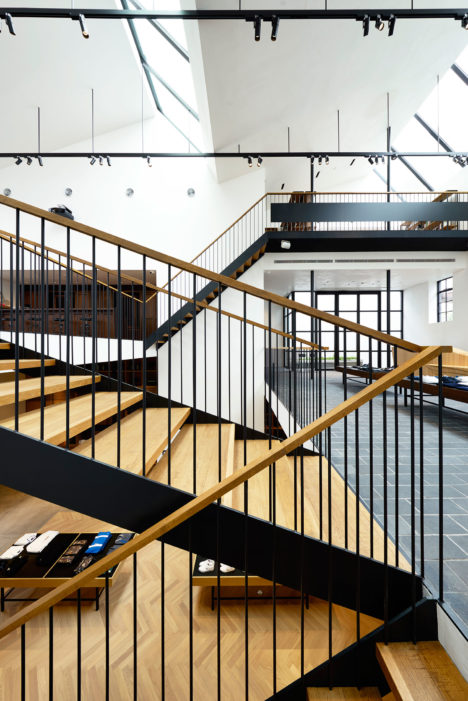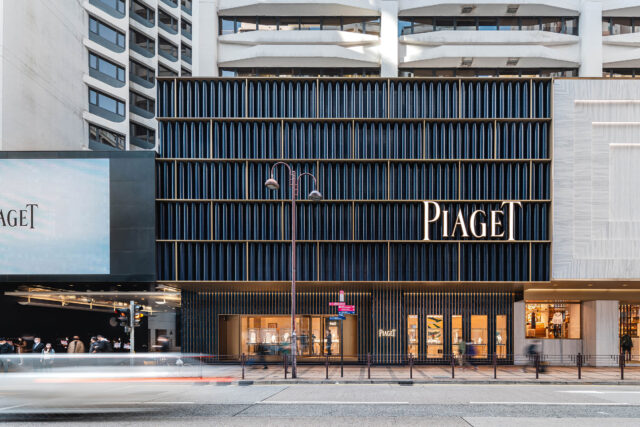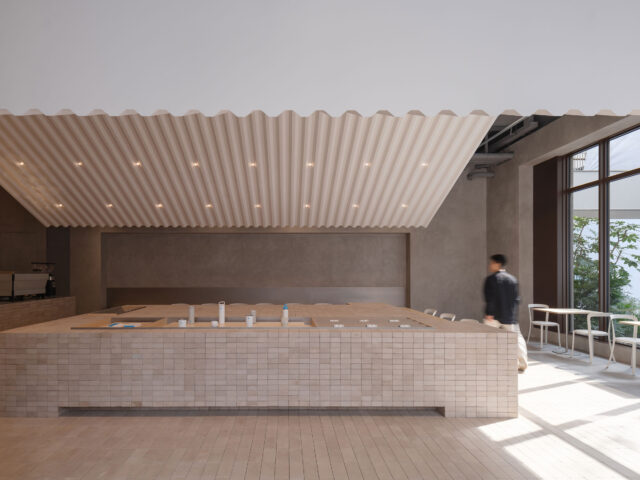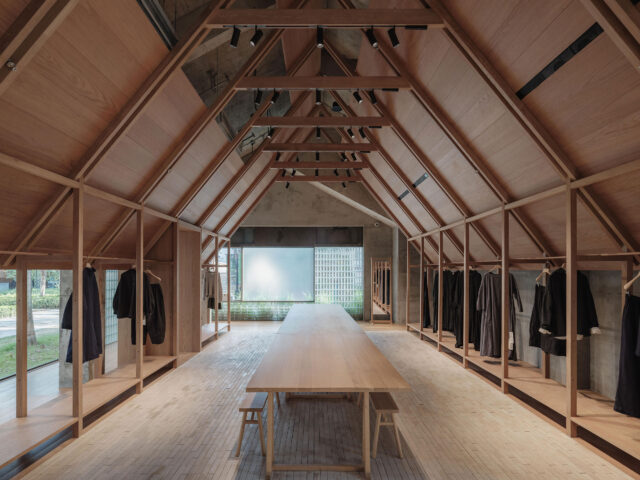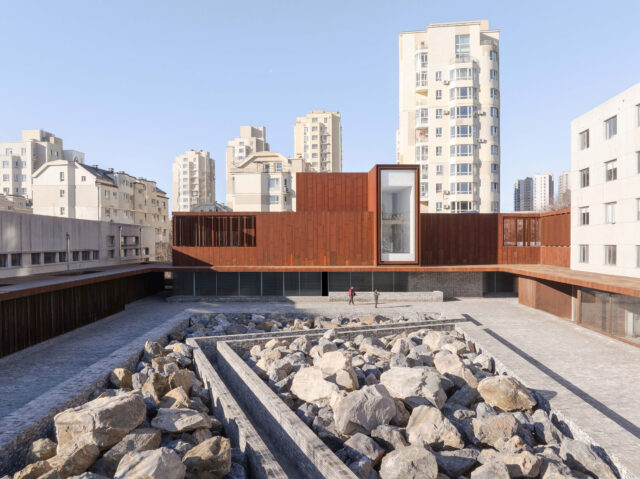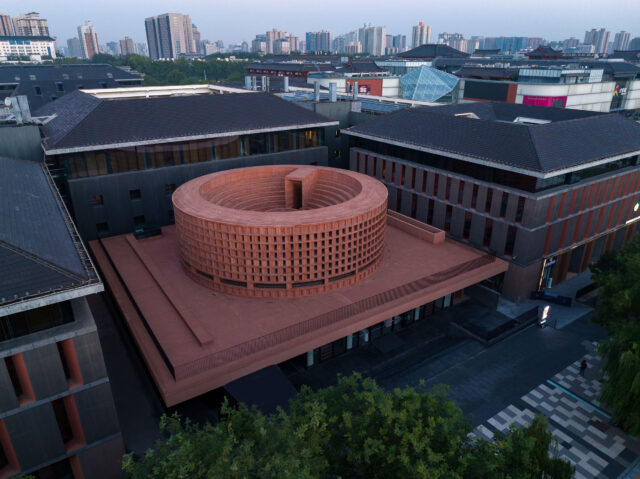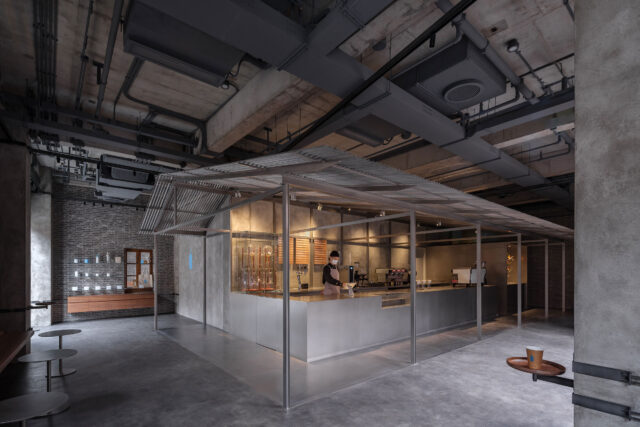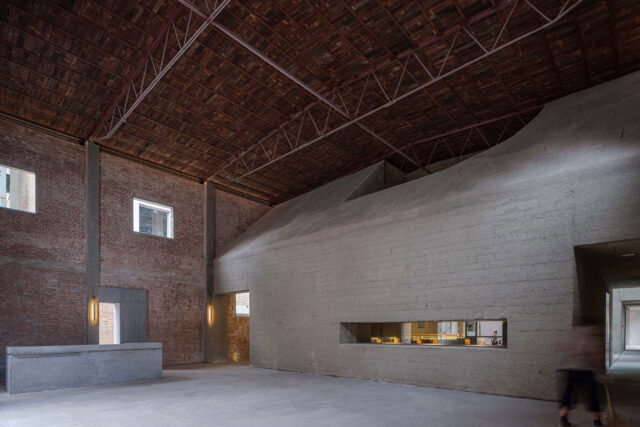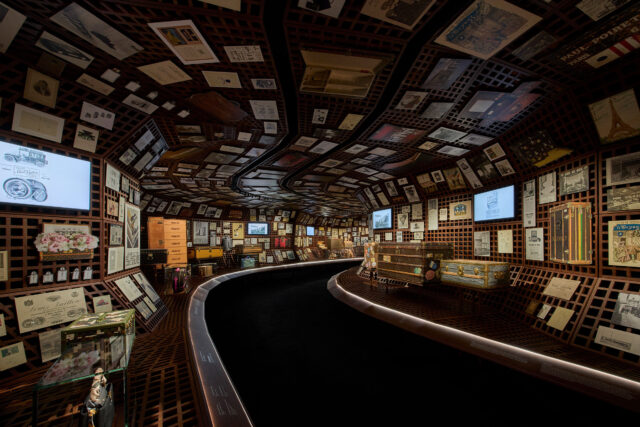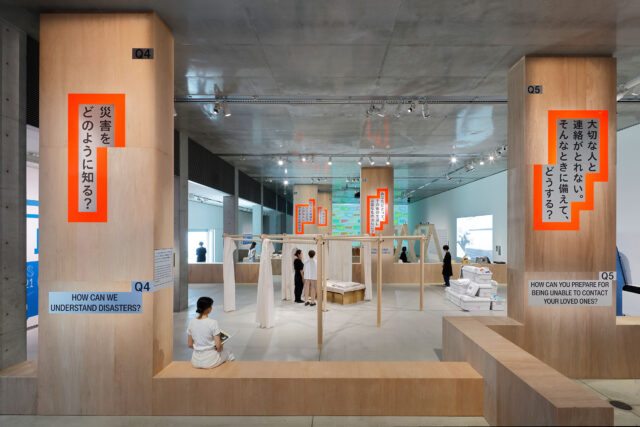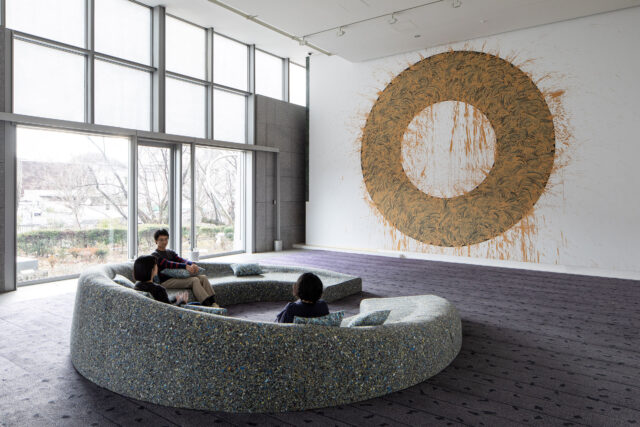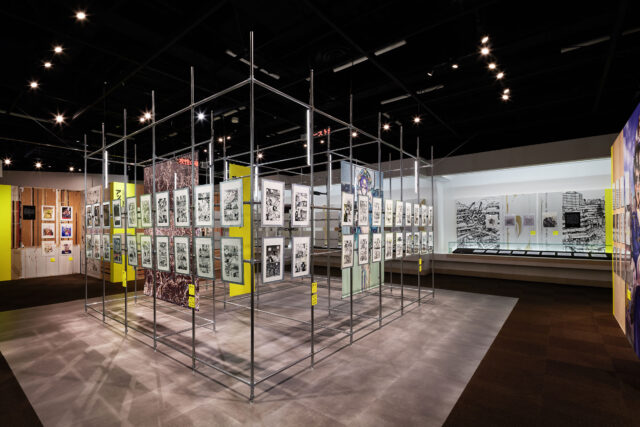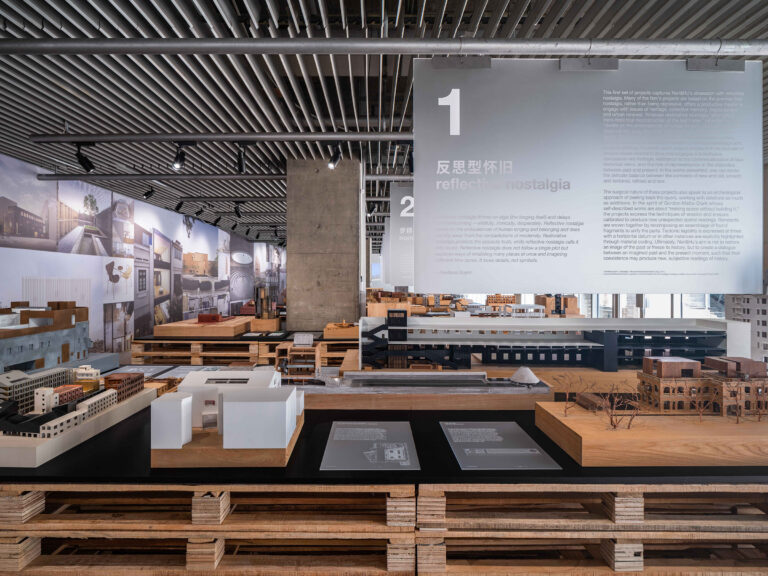
SHARE ネリ&フーの、中国・上海の同済大学での建築展「Neri&Hu: Works in Permanent Evolution」。自身の建築を6つの建築的視点から紹介



ネリ&フーの、中国・上海の同済大学での建築展「Neri&Hu: Works in Permanent Evolution」の会場写真です。自身の建築を6つの建築的視点から紹介する建築展です。会期は2021年5月15日まで。
以下は、建築家によるテキストの翻訳です
「Neri&Hu: Works in Permanent Evolution」は、ネリ&フーの建築作品を6つのカテゴリーに分けて包括的に紹介しています。「Reflective Nostalgia(思慮深い懐旧)」「Nomadic Voyeurism(放浪するのぞき見)」「Dwelling(住居)」、「Inhabitable Strata(生息可能な層)」「Recasting Vernacular(ヴァナキュラーの改変)」「Future Artifact(未来の人工物)」。
「Reflective Nostalgia(思慮深い懐旧)」から「Future Artifact(未来の工芸品)」に至るまで、本展は時間的な連続性と歴史をテーマにしたスペクトラムとして捉えられています。この展覧会では、さまざまなグローバルな文脈における一連の現代的な問題を検証し、適応的な再利用と歴史の役割に対する知的な探究心を維持すること、のぞき見と関連した空間の読みやすさの再構築、構造(テクトニクス)とポシェ(※建築物の設計図や断面図などで、黒く塗りつぶされる厚い壁や柱の部分)の使用、ヴァナキュラーへの回帰を模索すること、集合的な記憶と断片の役割など、我々がどのように仕事の根拠としているかに光を当てることを目的としています。
この展覧会では、これまでに発表されたことのない多くの模型を用いて、完成した建築、アンビルトの建築、スペキュラティブな作品を紹介しています。この展覧会は、絶えず変化する複数の要素間の対話として捉えられ、ネリ&フーの進化の瞬間を抽出し、捉えることを目的としています。
01 Reflective Nostalgia(思慮深い懐旧)
reflective nostalgiaは「人間の憧れと帰属の両義性を宿し、現代性の矛盾から逃れられない」という意味です。ネリ&フーのプロジェクトの多くは、遺産、集団的記憶、移転、都市再生などの問題に生産的に取り組む手段を提供しています。この章で紹介する作品には、新旧のコントラスト、滑らかさと質感、洗練されたものと生々しいものの間の微妙なバランスが感じられます。
02 Nomadic Voyeurism(放浪するのぞき見)
この章では、中国の庭園によく見られる「借景」という手法が、固定された境界線に対する私たちの認識に疑問を投げかける新しい見方を提供していることを紹介します。借りてきた景色は、一般的な見方の規範を覆し、空間の奥行きやスケールと距離の知覚を操作するような、正確な視覚的侵犯をもたらします。これらのプロジェクトはすべて、放浪しのぞき見する人の歩き回る目によってつなぎ合わされることを意図した断片の集合体の間の、部分と全体の関係を示しています。
03 Dwelling(住居)
「家」と「家にいること」は、シェルター、プライバシー、親密さ、安心感などの主観的な認識によって形成される心理的な構成要素です。住まいは、私たちの日常的な居住儀式の痕跡を残し、長い間、私たちの日常生活の中で蓄積された人工物の器としての役割を果たしています。住まいは、生活のための容器や背景としての役割を果たすだけでなく、私たちの最も親密な存在領域や個人的な愛着から導き出される私たちの価値観の表現でもあります。ハイデガーによれば、人は住めるようになってから建物を建てるのであって、住居とは世界に根を張ろうとする衝動の物理的な表れである。
04 Inhabitable Strata(生息可能な層)
建築とインテリア、外と内という二項対立は、ネリ&フーが実践を通して挑戦してきたものです。ガストン・バシュラールが雄弁に語ったように、これらの言葉は人間の経験を幾何学的に還元しているに過ぎず、生息の全スペクトルを表現するには足りません。ネリ&フーは、「物体性」に対する複雑な態度から、相反する極性を包含したいと考えています。形式的な読みやすさを確立した後の衝動は、内部から形を問い直すことです。
05 Recasting Vernacular(ヴァナキュラーの改変)
中国のヴァナキュラー・タイポロジーは、新しいプロジェクトをより広い歴史的コンテクスト、地元の血統、特定の土地に結びつけるための情報として重要です。最近の調査では、タイポロジーに加えて、ヴァナキュラーな建築材料や建築方法にも目を向け始めています。タイポロジーへのアプローチと同様に、時代遅れの手法を移植したり、過去の要素を直訳したりするのではなく、それらを新たに解釈することを目指しています。
06 Future Artifact(未来の人工物)
アルド・ロッシは、都市を常に意識と記憶を持って変化し、蓄積していく生きた存在と考えました。建築の価値は、機能を失った後も都市を構成し続ける人工物の形態にあります。ネリ&フーが提起する問題はシンプルで、世代を超えて意味のある存在であり続ける建築物をいかにして作るかということです。この章では、ネリ&フーが文脈、モニュメントの役割、破壊と進化の二重性といった概念をどのように扱っているかを紹介します。
以下の写真はクリックで拡大します















以下、建築家によるテキストです。
Neri&Hu: Works in Permanent Evolution
In a comprehensive manner, Neri&Hu: Works in Permanent Evolution presents the practice’s architectural works in six main categories: Reflective Nostalgia, Nomadic Voyeurism, Dwelling, Inhabitable Strata, Recasting Vernacular, and Future Artifact.
Seen as a spectrum, starting with Reflective Nostalgia and culminating with Future Artifact, the exhibition starts and closes on themes of temporal continuity and history. The exhibition examines a series of contemporary issues in various global contexts and aims to shed light on how the firm grounds its work — by maintaining an intellectual inquiry into adaptive reuse and the role of history, reimagining spatial legibility associated with voyeurism, tectonics and the use of poché, searching for a connection back to the vernacular, and the role of collective memory and fragments.
The exhibition showcases built, unbuilt and speculative work through models, many of which have never been shown before. Seen as a dialogue between multiple factors in continual flux, the exhibition aims to distill and capture a moment in time of Neri&Hu’s evolution.
01 REFLECTIVE NOSTALGIA
Reflective nostalgia “dwells on the ambivalences of human longing and belonging and does not shy away from the contradictions of modernity.” Many of Neri&Hu’s projects offers a productive means to engage with issues of heritage, collective memory, displacement and urban renewal. In the works presented in this chapter, one can sense the delicate balance between the contrasts of new and old, smooth and textured, refined and raw.
02 NOMADIC VOYEURISM
This chapter captures how the technique of “jiejing” (borrowed scenery), frequently found in Chinese gardens, offers novel ways of seeing that challenge our perceptions of fixed boundaries. Borrowed views defy accepted norms of viewing and exact visual transgressions that manipulate spatial depth and the perception of scale and distance. These projects all exhibit part-to-whole relationships between a collective of fragments meant to be pieced together by the roving eye of the nomadic voyeur.
03 DWELLING
Home and being “at home” are psychological constructs shaped by subjective perceptions of shelter, privacy, intimacy and sense of security. Dwellings bear the markings of our daily rituals of inhabitation and over time they serve as vessels for the accumulated artifacts of our everyday lives. Beyond serving as container and backdrop for life, dwellings are expressions of our values drawing from our most intimate planes of existence and personal attachments. According to Heidegger, we build only after we are capable of dwelling; dwellings are the physical manifestations of our impulse to find rootedness in the world.
04 INHABITABLE STRATA
The dichotomies of architecture versus interior, outside versus inside are binary relationships that Neri&Hu has been challenging through practice. These tropes, as Gaston Bachelard eloquently described merely reduce human experience to a geometrism that falls short of representing the full spectrum of inhabitation. The desire to embrace conflicting polarities stems from Neri&Hu’s complex attitude towards “objecthood”. The impulse after establishing formal legibility in is to interrogate the form from the interior.
05 RECASTING VERNACULAR
The vernacular typologies in China are critical in informing how Neri&Hu links new projects into a broader historical context, local lineage and specific site. Beyond typology, Neri&Hu’s recent investigations have also begun to look closer at the vernacular construction materials and methods. Similar as with the approach to typology, Neri&Hu does not seek to transplant outdated modalities, or take literal translations of a bygone element, rather to interpret them anew.
06 FUTURE ARTIFACT
Aldo Rossi conceived the city as a living entity, constantly transforming and accumulating its own consciousness and memory. Architecture’s value resides within the forms of urban artifacts, which continue to structure the city even after they have shed their functions. The question Neri&Hu raises here is simple: how do we create built artifacts that can retain a meaningful presence for generations to come? The works in this chapter present how Neri&Hu deals with notions of context, the role of the monument, and the duality of destruction and evolution.
■建築概要
Neri&Hu: Works in Permanent Evolution
Location: Shanghai
Date: 2021
Program: Exhibition
———
Special thanks: Dean Li Xiangning, Liu Kan, Wen Huajing and volunteers from College of Architecture and Urban Planning, Tongji University
Partners-in-charge: Lyndon Neri, Rossana Hu
Exhibition team: Christine Chang, Lina Lee, Junxi Lu, Guo Peng, July Huang, Luna Hong, Jeremiah Neri, Vivienne Shi, Yuxuan Wang, Nicolas Fardet
Acknowledgement: JAFFA Plastics (Shanghai) Co., Ltd, Shanghai Yixuan Model Design & Production Co.

